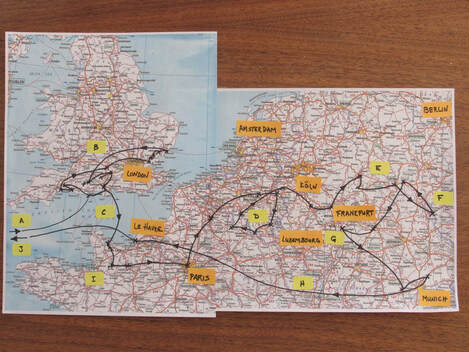 First Lt. James Vincent Pelosi flew B-17s and B-24s during World War Two, then flew cargo planes that shuttled food and supplies to the citizens of Berlin during the Berlin Airlift. In 2014, his son, Dr. James Joseph Pelosi, honored his father and the memories of other veterans by walking the route of the Allied Army from Omaha Beach to Berlin. That’s 844 miles. He carried 38 pounds on his back – about what a GI would have carried during WWII - with a two-person tent, a poncho to put underneath the tent, a sleeping bag, an air mattress, a raincoat, first-aid kit, flashlight, a few layers of clothing and personal hygiene items, two pairs of socks to rotate and five days’ worth of MREs (army rations), with periodic resupply points along the way. He wrote about his journey in 2017, publishing Normandy to Berlin: The Trek to Honor the Legacies. I have the greatest admiration for the guy, who is an aerospace biomedical engineer in Houston and was 62 at the time. What an accomplishment! I read about him yesterday and woke up this morning wondering how much rental cars are in Europe. That’s a bad sign. But 844 miles is less than the height of Texas. For a Texan, it’s only a two-day drive. The reason I was thinking about Europe was that my editor suggested that I be ready to give talks when my war-story book comes out. A local chapter of the Military Writers of America meets monthly in Albuquerque and I can see myself giving a presentation at one of their meetings. The local VFW meetings might also be a venue. I still don’t know much about the war, but my dad’s story would be resonant with many veterans, as well as children of veterans. In anticipation of that, and out of curiosity, I took my dad’s itinerary and used Google Maps to draw a fair representation of his route from the time he landed in England to the time he boarded a troop ship in France to come home. After the war was over, when he stepped onto familiar ground back in Ponca City, Oklahoma, he had been gone 3 years and 10 days. He had spent six months in the States, a year in England, and then, from stepping onto Omaha Beach to leaving Europe at the port city of Le Havre, he had spent 485 days in the middle of a war, traveling through France, Belgium, Holland, Luxembourg, Germany, and Czechoslovakia. The map with his route is in the photo, with a larger version on the MogiFranklin website. The letters on the map tell more of the story: A – He spent 6 months training in Florida, then left Camp Kilmer, New Jersey, on board the Queen Mary, on June 23, 1943 and arrived in England (probably at Portsmouth or Southampton) on June 30. B – He was in England from June 30, 1943, to June 27, 1944, working as an operator of a truck-based aircraft detection radar system. C - He landed at Omaha Beach on July 2, 1944, and set up his radar system a few miles away, just south of Point du Hoc, next to a temporary airfield created by Army engineers (AF-2). D – The “breakout” from Normandy occurred around August. His unit followed the First Army out of Normandy, helped them celebrate in a just-liberated Paris, turned north into Belgium and Holland, then back into Belgium. He was in Bastogne from October 29 to December 19, when the Germans began the Battle of the Bulge. The irregular loop on the map shows that his unit stayed close, but not too close, to the front line. E – After the battle ended in January, 1945, he was linked to the Third Army (Gen. George Patton) as they fought their way into Germany, from January through April, 1945. F – He moved into Czechoslovakia on May 1, and was there when Germany surrendered on May 8. G – During the Allied Occupation period after the war, he spent 3 months at the 86th Replacement Depot in Darmstadt, then was stationed at the Furstenfeldbruck Air Field outside of Munich when he received orders to go home. H – It took a 24-hour bus ride to get from Munich to the port city of Le Havre, but I bet no one complained. He waited a week to board his troop ship. I – I believe that one of the things he did during that week was to take an Army-sponsored excursion to Mont St. Michel, which was about 3 hours away. A photograph shows he was there. J – Finally, after 485 days from when he landed on Omaha Beach (about 30 miles away), he boarded a ship in Le Havre and, 178 hours later, walked down the gangplank into New York City on November 16, 1945. He made it home at 4:00 in the morning on Friday, November 23rd, 1945, just in time for Thanksgiving. His war was finally over.
0 Comments
Leave a Reply. |
AuthorDon Willerton has been a reader all his life and yearns to write words like the authors he has read. He's working hard at it and invites others to share their experiences. |

 RSS Feed
RSS Feed